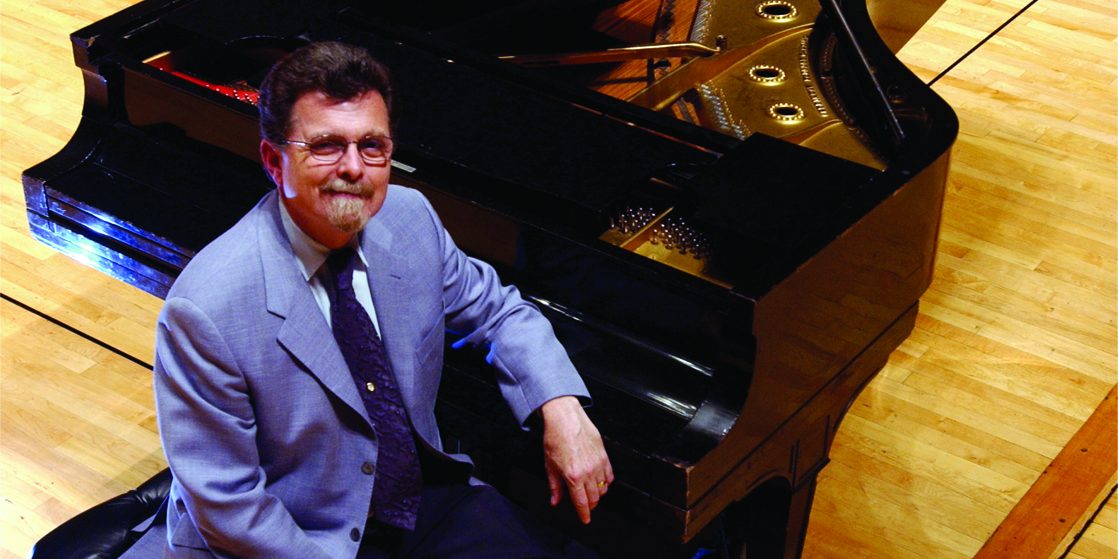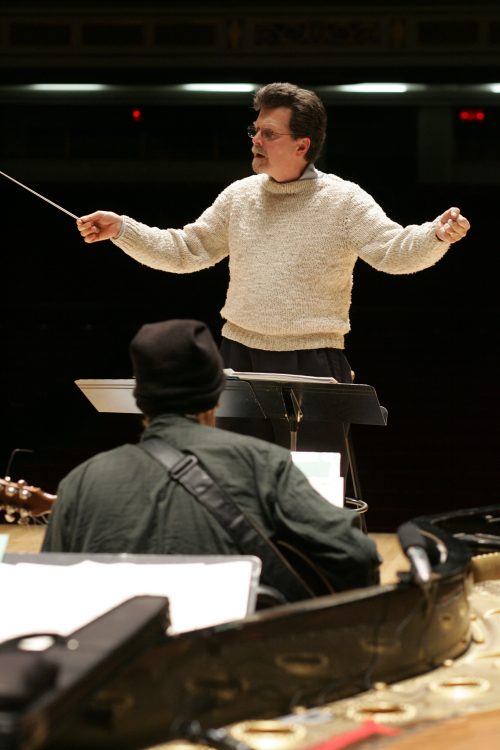By Dan Gross
Pianist-composer Bill Dobbins has been an esteemed member of Eastman’s jazz faculty twice: from 1973 to 1994, and again from 2002 to the present. He is now Professor of Jazz Studies and Contemporary Media, as well as conductor of the Eastman Jazz Ensemble and Eastman Studio Orchestra. His Eastman career has spanned virtually the entire history of jazz at the school, and he worked alongside such revered figures as Rayburn Wright, Fred Sturm, Chuck Mangione, and others.
On May 3, 2017, he celebrated his 70th birthday with a solo recital in Hatch Hall. Shortly afterwards, we caught up with Bill Dobbins in a wide-ranging chat about his life, jazz at Eastman, and jazz in general. This is Part I of our interview.
You started here in 1973. What were the early days of the Eastman Jazz Department like, and what was your role here?
A lot of things were started in the ‘60s by Chuck Mangione, who already had a big band and a course in improvisation here. Then, around 1970, Chuck did a concert with the Rochester Philharmonic Orchestra that featured his music arranged for orchestra, with some singers and well-known musicians from this area involved. The LP was released by Mercury Records [Friends and Love, 1970], so Chuck decided to leave his instructor position he had here, and try to make it, which he did.
When Ray Wright [who started teaching at Eastman in 1970] had this idea of starting a master’s degree program, I ended up getting hired for this new master’s degree program. Ray would cover the writing curriculum, but he needed someone to work with the small groups and work with the second band, and to cover the jazz history, harmony, and improvisation courses. That’s what I was hired to do in 1973.
Tell us more about Ray Wright and the famous summer Arranger’s Holidays.
Ray Wright was in the Glenn Miller Orchestra after Glenn Miller died; he was in the trombone section and did a lot of arranging for them, and when he got off the road, he settled in New York. He ended up as a staff arranger for Radio City Music Hall, working his way up to chief arranger and director of the orchestra.
Don Hunsberger [professor emeritus and former director of the Eastman Wind Ensemble; a friend of Ray Wright’s]– and maybe some other people as well – eventually talked Ray into beginning these “Arranger’s Holiday” programs, coming up during the summer with Manny Albam. I’m not sure when Ray and Manny got to know each other, but Manny was really one of the important big band arrangers; he wrote for dozens of bands that all the major labels were recording in the ‘50s and ‘60s, and for a lot of the famous road bands, including Buddy Rich and Woody Herman.
Ray and Manny were really good friends, and they started coming up in the late ‘50s, and I think their first Arranger’s Holiday guest was an African drummer named Babatunde Olatunji. They had guest artists every summer, and they ranged from singers like Carmen McRae and Sarah Vaughan to instrumentalists like Dave Brubeck, Duke Ellington, Hank Jones, Bob Brookmeyer, Phil Woods, J.J. Johnson… all the big names.
During the three weeks of the Arranger’s Holiday, in the morning students would have class sessions with Ray and Manny, and in the afternoon they would meet in Eastman Theatre with a professional big band, a small studio orchestra or a large studio orchestra, a film scoring group, a jazz ensemble (which was mostly current Eastman students and a few alums). And all of the members of the studio orchestra, the strings and percussionists mostly, were members of the Rochester Philharmonic.
The purpose of these sessions was for the ensembles to read the music that students were writing in the classes. Then at the end of the third week, they put on a concert. The first half was stuff students had written, and the second half featured the guest artist.
[In the late 1950’s, Eastman invited Wright to start a summer workshop for arrangers — the first time a jazz class had ever been officially offered at the School. The summertime Arranger’s Workshops became eagerly anticipated annual events, eventually growing into Arranger’s Holidays. By the late ‘60s and early 70’s, their popular closing concerts featured big-name performers like Duke Ellington, Dave Brubeck, Carmen McRae, Mel Tormé, and Marian McPartland. With Wright’s unprecedented emphasis on providing students with writing and arranging experience, Eastman became the place for bandleaders, artists, and television and film producers to contact for fresh material.]
When Ray had this idea of starting a master’s degree program, I ended up getting hired for this new master’s degree program. Ray Wright would cover the writing curriculum, but he needed someone to work with the small groups and work with the second band, and to cover the jazz history, harmony, and improvisation courses. That’s what I was hired to do in 1973.
By the summer of 1989, when Ray was diagnosed with brain cancer [he died in 1990], he realized that he wasn’t able to do the Arranger’s Holiday the following year. We tried to keep it going with Bill Holman and Manny, but even before Ray became ill, enrollment had dropped. There were already a number of comparative programs that weren’t as long or as expensive, so unfortunately we shut it down. It was an expensive proposition to have a group like that on stage for three hours, for maybe twelve of those fifteen days, to read this new music. It was a totally unique thing; I don’t know anything that ever existed quite on that level.


